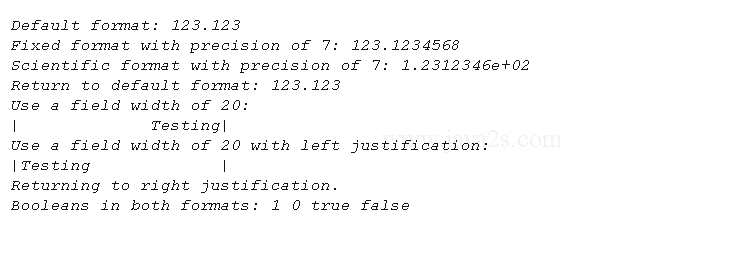Two basic types of I/O manipulators: parameterless and parameterized. - C++ File Stream
C++ examples for File Stream:cout
Introduction
The parameterless manipulators that operate on output streams are shown here:
| Manipulator | Purpose |
|---|---|
| boolalpha | Turns on boolalpha flag. |
| endl | Outputs a newline. |
| ends | Outputs a null. |
| dec | Turns on dec flag. Turns off the hex and oct flags. |
| fixed | Turns on fixed flag. Turns off the scientific flag. |
| flush | Flushes the stream. |
| hex | Turns on hex flag. Turns off the dec and oct flags. |
| internal | Turns on internal flag. Turns off the left and right flags. |
| left | Turns on left flag. Turns off the right and internal flags. |
| noboolalpha | Turns off boolalpha flag. |
| noshowbase | Turns off showbase flag. |
| noshowpoint | Turns off showpoint flag. |
| noshowpos | Turns off showpos flag. |
| nounitbuf | Turns off unitbuf flag. |
| nouppercase | Turns off uppercase flag. |
| oct | Turns on oct flag. Turns off the dec and hex flags. |
| right | Turns on right flag. Turns off the left and internal flags. |
| scientific | Turns on scientific flag. Turns off the fixed flag. |
| showbase | Turns on showbase flag. |
| showpoint | Turns on showpoint flag. |
| showpos | Turns on showpos flag. |
| unitbuf | Turns on unitbuf flag. |
| uppercase | Turns on uppercase flag. |
To use a parameterized manipulator, you must include <iomanip>.
It defines the following manipulators:
| Item | Value |
|---|---|
| resetiosflags (ios_base::fmtflags f) | Turn off the flags specified in f. |
| setbase(int base) | Set the number base to base. |
| setfill(int ch) | Set the fill character to ch. |
| setiosflags(ios_base::fmtflags f) | Turn on the flags specified in f. |
| setprecision (int p) | Set the number of digits of precision. |
| setw(int w) | Set the field width to w. |
cout << setprecision(8) << left << 123.23; cout << setw(12) << fixed << showpos << 98.6 << setw(10) << avg;
The same result can be obtained by use of stream member functions, but in a less compact form:
cout.width(12); cout.setf(ios::fixed, ios::floatfield); cout.setf(showpos); cout << 98.6; cout.width(10); cout << avg;
Example,
Demo Code
#include <iostream> #include <iomanip> using namespace std; int main()//from w w w.j av a 2s . co m { cout << "Default format: " << 123.123456789 << endl; cout << "Fixed format with precision of 7: "; cout << setprecision(7) << fixed << 123.123456789 << endl; cout << "Scientific format with precision of 7: "; cout << scientific << 123.123456789 << endl; cout << "Return to default format: "; cout << resetiosflags(ios::floatfield) << setprecision(6) << 123.123456789 << "\n\n"; cout << "Use a field width of 20:\n"; cout << "|" << setw(20) << "Testing" << "|\n\n"; cout << "Use a field width of 20 with left justification:\n"; cout << "|" << setw(20) << left << "Testing" << "|\n\n"; cout << "Returning to right justification.\n\n" << right; cout << "Booleans in both formats: "; cout << true << " " << false << " " << boolalpha << true << " " << false << "\n\n"; cout << "Default: " << 10.0 << endl; cout << "After setting the showpos and showpoint flags: "; cout << showpos << showpoint << 10.0 << "\n\n"; cout << "The setw manipulator is very useful when repeated field\n" << "widths must be specified. For example:\n"; cout << setw(8) << "this" << endl << setw(8) << "is" << endl << setw(8) << "a" << endl << setw(8) << "column" << endl << setw(8) << "of" << endl << setw(8) << "words"; return 0; }
Result

Related Tutorials
- Use cout to write to a specific file instead of to the standard display device
- Create custom output manipulator and a custom input manipulator called skip_digits().
- Create simple parameterized input and output manipulators.
- Show justification format flags, the left, right, and internal format flags.
- Line Up Columns of Numbers